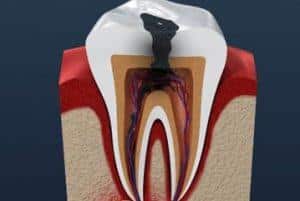What exactly is a Root Canal?
If you have experienced a tooth infection, then you know how painful and serious it can be. Here we will explain the details of the procedure for a root canal treatment for infected tooth pulp.
The goal of a root canal is to remove the infection and protect the tooth from future microbial invasion. A root canal is not a pleasant experience; however, it is completely worth it overall. Read on to learn more about this procedure and the treatment options available. In this article, we will discuss root canal pain, the reasons that people get tooth infections, and what you can do to reduce the discomfort.
Root Canal Treatment – Procedure
A root canal treatment removes the infected pulp and seals and protects the tooth from further damage. The goal of root canal treatment is to save the tooth.
Tooth infection may be caused by an untreated cavity, a cracked or chipped tooth from an accident, or occasionally complications from prior dental work. In some cases, a weakened immune system can result in tooth infection. Regardless of the type or cause of infection, there are several ways to ensure that your treatment goes as smoothly as possible.
Signs You May Need a Root Canal
- Pain while chewing or from hot or cold food or beverages
- Persistent throbbing toothache
- Fever accompanied by tooth pain
- Swelling in your face, cheek, or lymph node
- Red, swollen or bleeding gums
If you notice any of the above symptoms, you may need a root canal. A root canal will not only relieve pain but will also improve your general health and wellbeing. If you notice any of these signs, you should contact your dentist right away. The symptoms are not always immediately obvious; however, they should be taken seriously to ensure the health of your teeth and gums.
Pain Associated with a Root Canal
You might think that your tooth is infected if you experience persistent pain associated with your tooth. This pain is an indication that your tooth is damaged or needs treatment. Please do not ignore any warning signs that might indicate any type of tooth infection. It is always best to catch it early before the damage is too painful.
If you are experiencing any of the above-mentioned symptoms, contact your dentist as soon as possible for an examination. While waiting for your dentist appointment, you can alleviate the spread of infection and pain by keeping your mouth and teeth as clean as possible. Brush your teeth often, use mouthwash, and a warm salt water rinse.
Root Canal Treatment Options
A root canal is a common dental procedure, but the symptoms may not be obvious until the tooth has already become infected. Fortunately, root canal therapy can save the tooth, and eliminate the pain.
If you wait too long to see your dentist, you might end up with a serious infection and need to have the tooth extracted. If the infection does become too severe and the tooth must be extracted, you can discuss with your dentist to decide if a crown or bridge is an option.
What to Expect If you Need a Root Canal
If the infection is present, you will have to treat it with antibiotics before you can begin the root canal procedure. A root canal may take two visits to your dentist. The first visit will be to treat the pain and infection, and clean as much of the bacteria causing the infection as possible.
During this visit, the dentist will remove the nerve and clean and irrigate the infected area. They will then fill the tooth with a substance called gutta-percha which prevents recurring infection. The tooth is then sealed with a temporary filling.
The second visit will be to remove the temporary filling and replace it with a permanent filling. During this second visit, the dentist will also take an x-ray to ensure that the procedure was successful.
Possible Complications After a Root Canal
25 million root canals are performed annually, and 98% of the root canals completed are successful. However, occasionally some bacteria may stay behind in the tooth canal after the procedure and cause serious complications. The most common one is an infection of the bone surrounding the tooth.
Another complication can occur if there is a tine crack in the tooth that was not seen during the root canal. Another concern is if the seal on the tooth fails after some time. While these complications are highly unlikely, it is essential to see your dentist as soon as possible.
Call Casa Dental today, we’ll take care of your smile.









 REQUEST AN APPOINTMENT
REQUEST AN APPOINTMENT